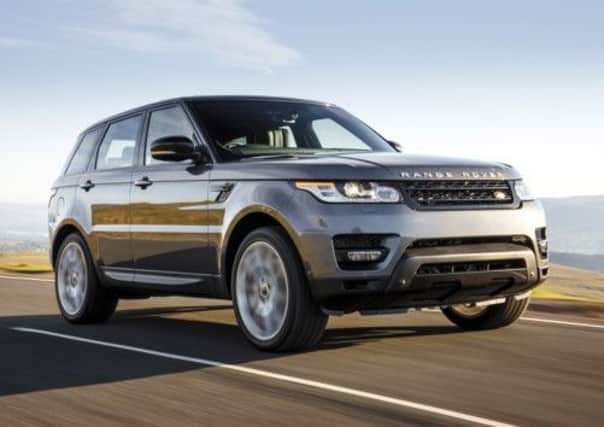Range Rover Sport shapes up


And let’s not kid ourselves about it’s sporting prowess… at two and a half tonnes, the RRS was more shot-putter than sprinter, a fact reflected in its on-road manners and fondness for fuel station forecourts.
Well you can stop your scoffing now, because a new Range Rover Sport is here that addresses many of the criticisms levelled at its predecessor. Scotsman Motoring took it for a punishing test drive and came away smiling. Why?
Advertisement
Hide AdAdvertisement
Hide AdWell, the new car is lighter for a start, by as much as 420kg. Gone is the steel chassis the old Sport shared with the Discovery, and in its place comes a lighter aluminium structure, just like the full-size Range Rover. Lighter weight means sharper handling, better performance and improved fuel economy. In the 288bhp V6 diesel we tested, the net effect is startling: Top speed leaps from 112mph to 138mph, the 0-60 dash is dispatched in 6.8 seconds instead of 8.8, and fuel economy is now 37.7mpg on the combined cycle, instead of 32.
It looks sportier too, with a streamlined nose, steeply-raked windscreen and tiny tail lights that make it appear less like a tarted-up mini Range Rover and more like the Evoque’s big brother. Even the interior has a pared-down feel, thanks to a touchscreen that houses many of the car’s controls and gives front-seat occupants a fairly button-free fascia over which to cast their gaze.
It’s still a Range Rover, mind, so there’s no scrimping on quality or creature comforts, from the luxury leather seats and panoramic sunroof to a sound system that can be heard on the moon. And, because it’s longer and wider than the car it replaces, with a longer wheelbase, there’s more room for everybody. There’s even a seven-seat option, with two perches that unfold electronically from the boot floor to seat two children. That’s something no “proper” Range Rover can boast.
Engine choices at launch are a silky-smooth 288bhp three-litre V6 diesel and a 503bhp supercharged V8 petrol that sounds fabulous but will punish you at the pumps. A detuned, 255bhp V6 diesel will follow, and a diesel-electric hybrid that’s tipped to have a CO2 figure of sub-150g/km will join the line-up in 2014.
On the road, you realise there’s more to that weight-saving than just numbers. The Range Rover Sport corners flat, with lots of feedback from the front wheels, and feels supple over the bumps. You sit high, but feel close to the road, if you catch my drift. Specify your car in “Dynamic” trim and you’ll get adaptive suspension that sharpens things up even more. Stick a tick in the “Sport” box.
With a mountain of torque from the diesel engine and seamless shifts from the eight-speed automatic gearbox, overtaking is swift and smooth. A 155mph sprint along a runway in the supercharged petrol car proved how unruffled the Range Rover is at high speed, although even the glorious bark of its exhaust note was trumped by the goosebump-inducing roar of a Rolls-Royce Merlin engine as a Hawker Hurricane sped past on its way to a nearby airshow.
It’s still the case that two wheels on the kerb outside the creche is as far from asphalt as most Range Rover Sports will stray, but Land Rover stakes its reputation on off-road prowess, so the Range Rover Sport comes with the full gamut of terrain-conquering tricks.
The Terrain Response dial has five settings, but leave it on auto and you can drive straight off the motorway and across a boulder field, or straight through a river, or up and down the sides of a canyon – as we did at Land Rover’s fearsome Eastnor Castle proving ground in the Cotswolds – and the car will work out the best mix of ride height and throttle settings by itself.
Advertisement
Hide AdAdvertisement
Hide AdThe Range Rover Sport can tackle water 850mm deep but, if you’re not sure how far up the sides of the car that is, the optional wading depth indicator will assist you with a dashboard display that shows the car sitting in what appears to be a rapidly-filling bath.
Top-end cars get a two-speed transfer box for the sort of super-low gears that will come in handy if you need to tow a boat to the top of Ben Nevis, plus torque vectoring that sends power to the front wheel with best grip. Tell that to the other parents at the creche and watch them swoon.
Sports car, limousine, people carrier, mud plugger… if Land Rover bosses set out to relieve the Range Rover Sport of its wannabe tag and give it an identity of its own, then we say: Mission accomplished, with bells on. It has evolved into a car so complete that it makes you question the sanity of anyone who still wants to spend £100,000 on a “proper” Range Rover.
VITAL STATS
CAR Range Rover Sport 3.0 SDV6 Autobiography Dynamic
PRICE £74,995
PERFORMANCE 0-60mph 6.8 sec; Top speed 138mph
MPG (combined) 37.7mpg
CO2 EMISSIONS 199g/km